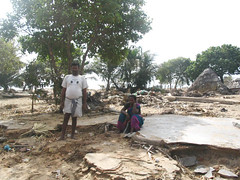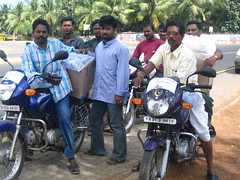Recounting the visit to the affected places
We started at 5:45 in the morning on the journey across the east coast road to visit the affected hamlets. The purpose of the visit was to identify the real needs of the people instead of blindly buying materials that people may have already got. We have collected money and wanted to make sure it was used properly. We planned to meet the people in person and get an understanding of the scenario. In retrospect, even if it meant doing an extra journey, it was a good decision, for we got to get the true picture.
From far, the scenic beaches looked as pretty as ever. Sometimes it makes you wonder if there was a tsunami attack at all.
It is only when you get off the road and walk near the sea shore do you get to see the power of those powerful waves. The water had clearly come a long distance inland. In this picture, you see the water flowing back into the sea.
This picture will give you a better indication of how far the water had come inland. Take a look at the catamaran and how far it has been washed inland by the sea waves. In the background, towards the left, you will see the village that had got devasted by the waves.
Some portions of the shore had high embankments but they had simply been eaten away.
There was a surprising amount of plasic garbage that was being washed ashore. This area is sparesely populated, so these could not have come from this place. These must’ve been sucked in from towards the city when the waves crashed in and later deposited miles away.
Waves so powerful they knocked off stone walls.
A view of the side wall belonging to the same house.
As we neared the first of the fishing hamlets, we noticed that relief camps have already sprung up. It was the general public that were the first to offer help. They had already pitched in to set up these tents to keep the people from the cold during night. Chennai can get uncomfortably cold with all the dew, if you don’t have a roof over your head.
You can still see the fear in the eyes of the villagers. Even if some of the huts were livable, they say that they can never sleep in peace. Most of them preferred to use these relief camps that have been set up away from the sea waters.
As we drove along further down the road, we found used clothing strewn around in many places. Yet another indication of over-supply in the same places. Hence it is very important to understand what people need before supplying it to them. Here’s one more lesson to learn. However homeless a person is, he still does not prefer dirty or torn clothes. So if you are contemplating giving your used clothes, please be considerate to give only the good ones and make sure they are washed clean.
Upon a closer inspection of a hamlet is when you the reality stares at your face. Entire sections of huts have simply vanished. This hamlet is called ‘Puthu Nemmeli Kuppam’and I have a soft corner for this one. This reminds me of the gaulish village. Offers a fantastic sight from the road with the sea as the backdrop.
I had a detailed talk with Parasuram, a resident of the hamlet. He narrates that he was deep into the sea fishing, along with other fishermen, and they never felt a huge wave coming. So he was extremely surprised when they reached the shore to find their village completely devastated. He was later informed by the womenfolk that there were three waves that stuck off which the third one was the most destructive. Thankfully, the first two waves were not that strong and acted as warning. Most folks had been able to move away, either swim away or latch on to the wooden catamaran that parked inland. He says that if the third wave had stuck first, the entire village would have been dead. Miraculously, there was no casualty in this hamlet.
This was a poignant sight that tugged my heart. I saw this man and his wife there at this place which once was their home. They didn’t cry, wail or say a single word. For a long time, the woman just sat there and man just stood there. Neither saying a word to each other. There was sorrow written all over their place. I felt very awkward when I approached them to ask if it was okay to take a picture of them.
This motorboat had crashed into a hut.
It was heartening to see this old man come and distribute food to the people. The villagers said that they never starved because people were constantly coming in to offer food. When I spoke with a guy, I noted a hint of a tear drop in his eye obviously overwhelmed bythe kindness and support he sees from the people.
The government too swung into action. They dropped these sacks of rice and new dresses for men and women. They did this for every single hamlet that we passed by. I was pretty impressed.
Here, govt workers spreading bleaching powder to make sure that there is no water borne disease. They worked with surprising enthusiasm, the type I rarely get to see from government folks.
I didn’t like what I saw. This is definitely not a time for politics and I saw this guy paint the colours of a political party, obviously to please the politicians who were expected to visit the place.
During the entire trip, I saw a lot of vans and lorries from various relief organisations with cloth banners like the one you see above, scurrying past. There definitely is some hyperactivity in terms of relief activities which is a heartening sign.
We made a quick trip to the crocodile park to make sure the crocs were fine. Thankfully, nothing happened. I spoke the manager and he told me that had the water flooded in, most of the crocs would’ve died because they are not used to the salt water. He also told me that they while selecting the place to form the park many years ago, they had specifically chosen a higher ground to set it up. He says that is what saved the park now.
This is what remains of the ramp of Muthukadu Boat Club.
While returning back to the city, we came across this group of friends who had put in their own money to buy food items for villagers. They said that they preferred to serve the people directly instead of giving money to other organisations. Their enthusiasm was infectious.






















